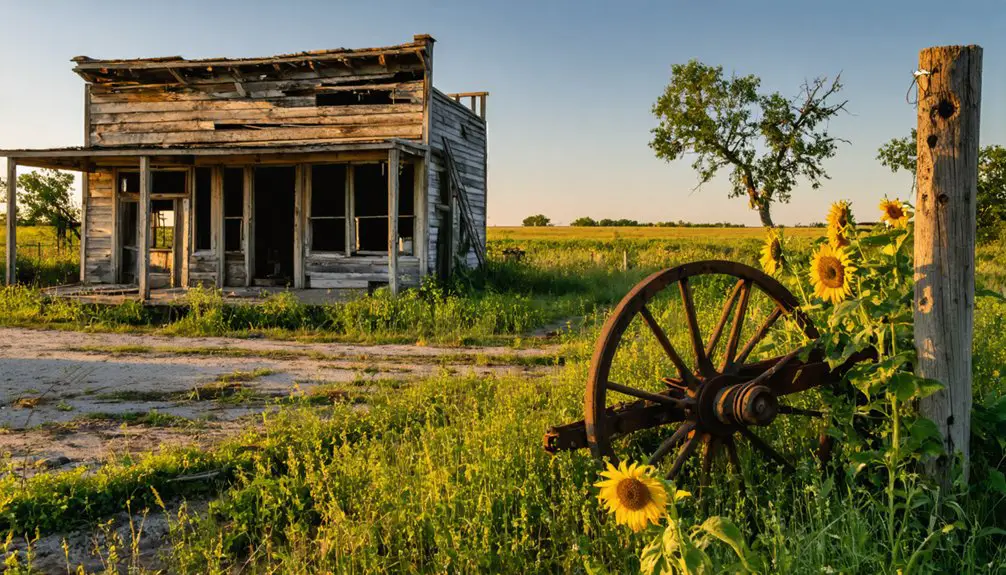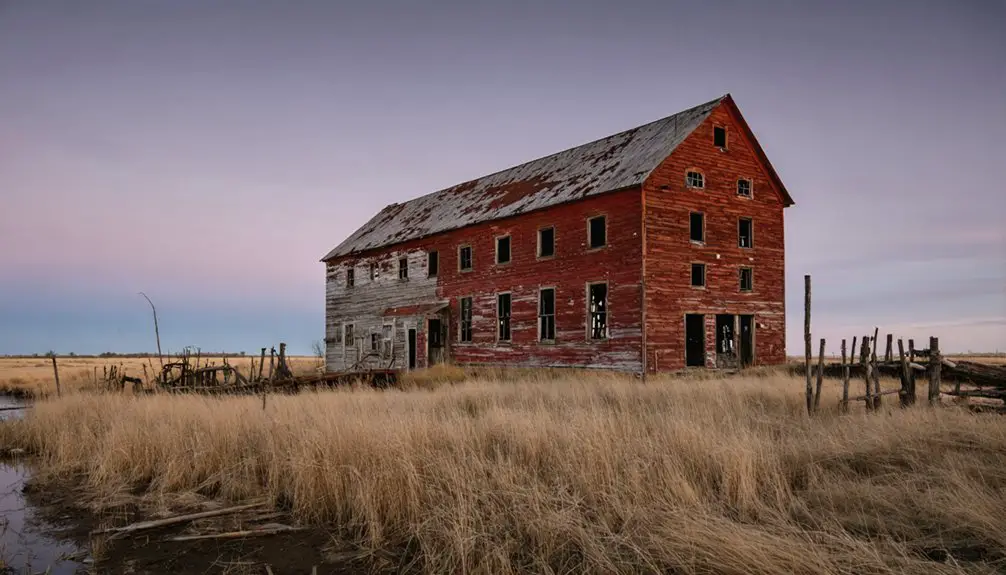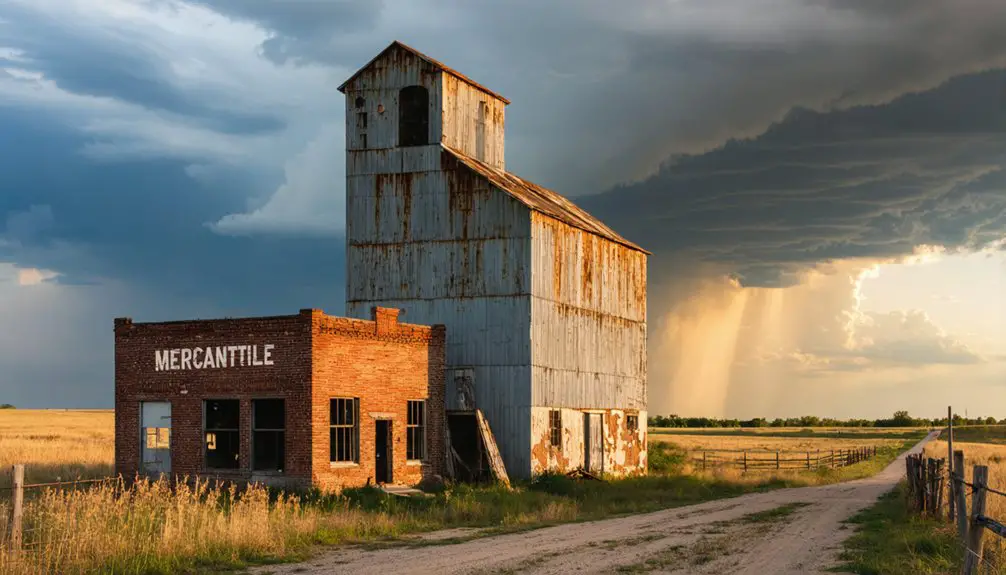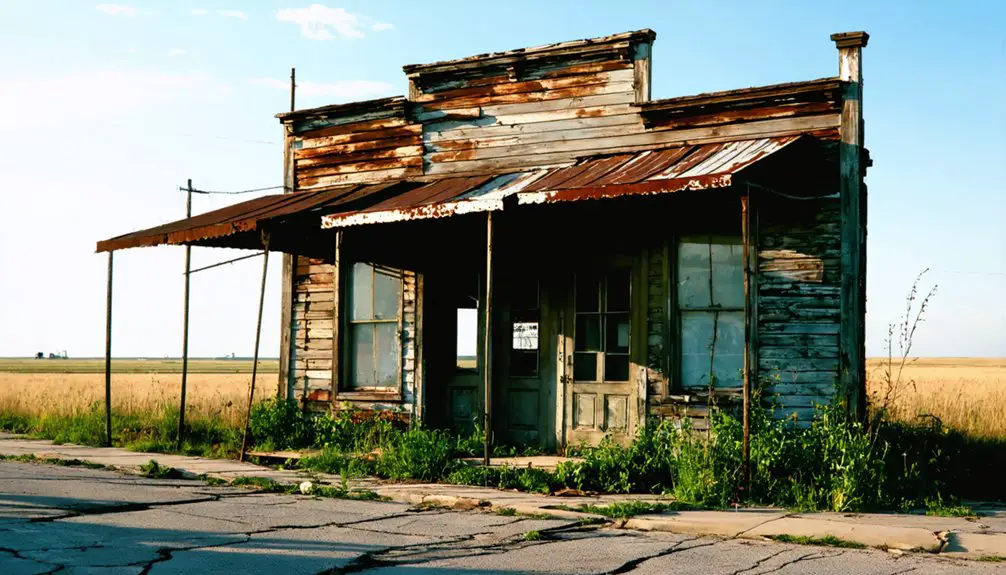You’ll find Cincinnati, Nebraska’s remains along the Nemaha River, where this once-promising frontier settlement emerged in 1857. The town flourished briefly through river commerce and local agriculture, but when the Rock Island railroad bypassed it in favor of nearby Dubois in 1886, Cincinnati’s prospects dimmed. Though it never exceeded 100 residents, Cincinnati’s story captures the boom-and-bust cycle of many Nebraska frontier towns, with preserved landmarks offering glimpses into pioneer life.
Key Takeaways
- Cincinnati was founded in 1857 along the Nemaha River but never exceeded 100 residents throughout its history.
- The town’s decline began when the Rock Island railroad bypassed it in favor of nearby Dubois in 1886.
- Strategic location between a lake and river initially supported commerce, but limited rail access ultimately led to economic failure.
- Archaeological remains and historic markers now preserve the memory of this Nebraska frontier settlement established by diverse pioneers.
- The ghost town site attracts heritage tourists and is maintained by the Cincinnati Preservation Association and Nebraska State Historical Society.
Early Settlement Along the Nemaha River
Settlement along Nebraska’s Nemaha River began in earnest when pioneers first arrived in Pawnee County in 1854, drawn to the rich possibilities offered by the river’s two main branches – the North Fork and South Fork.
You’ll find that early settlement patterns centered on strategic locations, with pioneers establishing homesteads one to two miles from the river to balance resource access with flood safety.
The area’s cultural influences grew diverse as settlers arrived from Tennessee, Iowa, Illinois, and Missouri, later joined by European immigrants from Germany, Sweden, Wales, and other nations.
In 1857, the town of Cincinnati emerged between a small lake and the Nemaha River, exemplifying the careful planning that went into choosing sites that could sustain thriving communities.
Lewis and Clark’s expedition had previously documented this region when they observed Native American burial mounds near the Big Nemaha River on July 11, 1804.
The region’s French heritage became evident through the arrival of traders like John B. Didier, who settled in the area after emigrating from France in the 1850s.
Life in 19th Century Cincinnati
You’d find Cincinnati’s daily pioneer life centered around the bustling Ohio River ports, where merchants traded goods ranging from locally-processed pork to agricultural products bound for New Orleans.
The city’s thirty warehouses supported this thriving commercial activity, storing goods for both military and civilian travelers. The city’s vibrant social scene included taverns, hotels, and restaurants that served both weary travelers and local residents seeking community connection.
Your typical 19th century Cincinnatian might spend evenings at community gatherings or local theater productions, activities that bridged social classes in this economically dynamic river town. The rapid growth brought by German immigrants transformed the cultural landscape, as they established a strong presence in four of the city’s twelve wards by 1850.
Daily Pioneer Activities
Life in 19th century Cincinnati reflected the dynamic social and economic changes sweeping through America’s frontier towns. Your pioneer routines would’ve centered around distinct gender roles, with women managing household affairs while men pursued trades like furniture making, butchering, or brewing.
You’d find yourself deeply embedded in community roles, participating in frequent social visits and church gatherings that strengthened neighborhood bonds. Daily life wasn’t just about work – you’d spend considerable time maintaining social connections through extended visits and shared meals with neighbors.
Your economic prospects could change rapidly in this bustling river town, where steamboat trade and canal transport created opportunities for advancement. You’d likely engage in small manufacturing or service professions, adapting to the town’s growth as “Porkopolis” became a major commercial center. The city’s prime location on the Ohio River since 1811 enabled significant growth through steamboat commerce, transforming Cincinnati into a thriving transportation hub.
River Trade Dynamics
Beyond the daily rhythms of Cincinnati’s frontier society, the Ohio River shaped every aspect of the town’s existence. You’d find river commerce pulsing through Cincinnati’s heart as barges and keelboats navigated the waterways, connecting settlers to essential trade networks. The river’s elevation drop of 26 feet at the Falls of the Ohio posed significant navigational challenges for traders.
The 64-ton barge “Cincinnati” made history in 1811, requiring eighteen men to warp it upstream, marking a new era in river transportation.
You’d witness the transformation of Cincinnati into “Porkopolis” as massive shipments of pork, grain, tobacco, and furs flowed southward to New Orleans. The construction of major canals enhanced the city’s position as a vital trade crossroads. While the journey upstream could take up to 50 days, the river served as a crucial lifeline for frontier economies.
Commercial houses managed the complex freight operations, helping integrate the region’s products into national and international markets despite challenges like river pirates and difficult navigation.
Social Gathering Places
While river commerce drove Cincinnati’s economic growth, the city’s social fabric was woven through its diverse gathering spaces. You’d find elaborate social dances hosted in prominent families’ homes, complete with gardens and circular driveways designed to welcome guests in style.
The Cincinnati Music Hall stood as the crown jewel of cultural life, hosting everything from symphonies to the renowned May Fest. The venue attracted legendary performers like Bruce Springsteen and Elton John throughout its storied history. These gatherings often featured scholarly discussions on urban issues, following Professor Miller’s belief that civic activity drives democracy forward.
Community gatherings took many forms, from structured “socials” where couples would rotate partners every 15 minutes to guarantee everyone mixed, to public lectures addressing urban change and social justice.
If you were a settler seeking connection, you’d discover a rich tapestry of entertainment and discourse at these venues, where local elites and visitors alike could escape isolation through cultural enrichment and meaningful social interaction.
Transportation Routes and Economic Growth
If you’d visited Cincinnati in its early days, you’d have found a settlement strategically positioned on the Nemaha River, where water transport and mill operations formed the backbone of local commerce.
While the town initially prospered from river-based activities, its fate was sealed when the Rock Island railroad bypassed Cincinnati in favor of nearby Dubois. This situation mirrored the impact of mass evacuations in other American towns, like those that occurred in Boston Township, Ohio in 1974.
The lack of rail access prevented Cincinnati from competing with railroad towns, leading to its economic decline as regional trade patterns shifted away from river-dependent communities.
River Travel Routes
As Native Americans pioneered river navigation in the Cincinnati region with canoes, they established essential transportation patterns that would shape the area’s development for centuries to come.
These trade routes along the Ohio River became crucial corridors of commerce, first with flatboats and later with powerful steamboats that could navigate upstream against strong currents.
You’ll find that river travel wasn’t just about moving goods – it connected frontier settlements and opened new possibilities for trade.
The introduction of steamboats transformed isolated outposts into bustling commercial centers, while strategic river routes through Cincinnati and Nebraska City created shorter paths to western destinations.
Railroad Access Impact
Once railroads emerged as the dominant transportation force in the late 19th century, they fundamentally shaped the destiny of towns like Cincinnati, Nebraska.
The railroad’s influence determined which communities would thrive and which would fade into obscurity. You’ll find that towns strategically positioned along rail lines experienced significant advantages:
- Increased commercial activity and trade opportunities
- Enhanced ability to ship agricultural products to distant markets
- Development of supporting businesses like warehouses and merchants
When railroad companies began consolidating their routes and centralizing operations, smaller towns often faced economic decline.
If you lived in Cincinnati during this period, you’d have witnessed how the loss of regular rail service could swiftly transform a bustling community into a ghost town, as businesses closed and residents sought opportunities elsewhere.
The Rise and Fall of a Frontier Village

During the mid-1800s, Cincinnati, Nebraska emerged as a modest frontier village along the Nemaha River south of Dubois. With hopes of tapping into river commerce, early settlers established basic infrastructure and businesses to serve both locals and travelers.
The community’s resilience was tested as residents carved out a life on the frontier, creating social spaces amid challenging conditions.
You’d have found Cincinnati’s decline tied closely to the era’s shifting transportation priorities. As railroad development favored nearby towns like Dubois, Cincinnati’s strategic importance as a river settlement diminished.
The village’s population, which never exceeded 100 residents, gradually dwindled as people sought opportunities in better-connected communities.
Today, Cincinnati exists primarily in historical records, joining other Nebraska ghost towns as a reminder of the territory’s dynamic settlement period.
Historical Connections With Dubois
While Cincinnati remained a small village with limited transportation access, Dubois emerged as a more prominent railway hub when it was platted in 1886.
You’ll find that trains #318, #330, and #353 regularly stopped at Dubois station, fostering stronger economic connections throughout the region.
Both communities shared essential resources and infrastructure, including the Cincinnati grist mill on the Nemaha River, which served residents from both settlements.
Railroad Access Differences
As railroad development shaped Nebraska’s landscape in the late 19th century, Cincinnati and Dubois emerged with markedly different rail connections that would influence their destinies.
The railroad importance between these two communities couldn’t have been more distinct in their transportation evolution.
While Dubois thrived as a dedicated railroad town along the Rock Island line, Cincinnati maintained only modest rail connections.
You’ll find these key differences shaped their paths:
- Dubois enjoyed direct Rock Island line access, fostering robust economic growth
- Cincinnati served as a minor rail stop with limited infrastructure
- The Rock Island’s presence made Dubois a stronger commercial hub, while Cincinnati’s weaker rail links restricted its development
These contrasting rail fortunes would ultimately play an essential role in their respective futures, with Dubois initially flourishing while Cincinnati struggled to maintain prominence.
The neighboring communities of Cincinnati and Dubois shared far more than their geographic proximity in Nebraska’s early days.
You’ll find evidence of their deep cultural exchanges through numerous shared social events, from theatrical performances at Dubois’ Knights of Pythias hall to joint community gatherings that drew residents from both towns.
Their community support networks were remarkably intertwined, with families maintaining strong kinship ties across town boundaries.
When facing challenges like horse theft, residents from both communities banded together in mutual vigilance.
The towns’ shared heritage lives on through preserved photographs, written accounts, and oral histories passed down through generations.
Even today, historical societies maintain collections that showcase how these two communities relied on each other’s social halls, markets, and fraternal organizations.
Agricultural Heritage and River Trade

Located along the South Branch of the Nemaha River, Cincinnati’s agricultural heritage flourished in the mid-1800s through a combination of diverse crop production and river-based commerce.
You’ll find early farmers embraced crop diversification, growing everything from corn and wheat to hemp and tobacco, though economic challenges often meant grain crops barely covered expenses unless used for livestock feed.
The river played a crucial role in the area’s development:
- A water-powered grist mill processed local grain
- River transport enabled grain shipments, including an 1859 delivery of 80 bushels of oats to Fort Kearney
- River trade complemented emerging railroad connections in the 1870s
Despite these advantages, Cincinnati’s farming community transformed as larger operations absorbed smaller farms, reflecting the broader agricultural shifts of the late 19th century.
Archaeological Remnants and Landmarks
Spanning multiple occupation phases from prehistoric times through early settlement, Cincinnati’s archaeological legacy reveals a rich tapestry of human activity.
You’ll find evidence of delicate quartz crystal tools and lithic points dating back 1,500 years, showcasing the area’s archaeological significance through refined prehistoric craftsmanship.
The site’s cultural continuity is demonstrated through layered deposits left by various indigenous groups, including the Plains Apache, Arapahoe, Pawnee, Cheyenne, and Sioux.
While the ghost town itself retains foundational remnants of pioneer structures, nearby landmarks like Robidoux Pass preserve reconstructed trading posts that tell the story of Nebraska’s settlement period.
These archaeological features, along with protected burial sites and cultural deposits, provide vital insights into the region’s complex human history, though access to many sensitive areas remains restricted.
Legacy in Nebraska Settlement History
Emerging as one of Pawnee County‘s earliest villages in 1855, Cincinnati played a pivotal role in southeast Nebraska’s settlement patterns during America’s westward expansion.
You’ll find that settler resilience defined Cincinnati’s story, from its destruction in 1864 to its rebuilding and eventual relocation across the river in 1886.
The town’s legacy represents key aspects of frontier development:
- Cultural intersections between settlers and Pawnee tribes shaped territorial dynamics
- Adaptable community planning enabled survival through environmental challenges
- Strategic positioning along Turkey Creek demonstrated settlers’ resourcefulness
Cincinnati’s experience mirrors the broader pioneer narrative of Nebraska’s development, where small settlements contributed to the region’s transformation.
Though the town peaked at just 100 residents, its impact on early county organization and settlement patterns remains significant in understanding your state’s frontier heritage.
Preserving Cincinnati’s Memory
Through dedicated preservation efforts since 1964, Cincinnati’s historic legacy has found robust protection under organizations like the Cincinnati Preservation Association and Nebraska State Historical Society.
You’ll find their work encompasses memory preservation through Standing Structure Surveys, historic markers, and educational programs that keep the town’s cultural heritage alive.
These organizations don’t just focus on architectural landmarks – they’re committed to preserving ordinary neighborhoods and everyday stories that shaped Cincinnati’s character.
Beyond grand monuments, preservation means protecting the humble spaces and daily tales that built Cincinnati’s unique identity.
They’ve partnered with local councils, museums, and development corporations to document and protect significant structures while promoting sustainable growth.
Through storytelling events and community outreach, they’re ensuring that future generations will understand Cincinnati’s role in Nebraska’s settlement history, even as they face ongoing challenges from demolition and neglect.
Regional Ghost Town Tourism
Cincinnati’s history as a ghost town has sparked growing interest among heritage tourists seeking authentic glimpses into Nebraska’s past.
Ghost town preservation efforts face unique tourism challenges in the region, yet dedicated visitors continue exploring these historic sites for their educational and cultural value.
You’ll discover several compelling aspects that make Cincinnati worth visiting:
- Authentic ruins and remnants that provide a tangible connection to Nebraska’s pioneer era
- Opportunities for photography and solitude in a scenic rural setting
- Integration with nearby natural attractions and historical sites
While accessibility can be limited due to the remote location, Cincinnati’s potential as a heritage tourism destination continues growing.
The site offers a fascinating window into regional history, attracting those interested in experiencing firsthand the stories of Nebraska’s abandoned settlements.
Frequently Asked Questions
Were There Any Notable Crimes or Unsolved Mysteries in Cincinnati’s History?
You won’t find documented unsolved crimes or ghostly sightings here – historical records show no notable criminal events. The town’s brief existence and decline were remarkably peaceful compared to surrounding settlements.
What Native American Tribes Originally Inhabited the Cincinnati Area Before Settlement?
You’ll find evidence of the Omaha tribe’s rich tribal culture and historical artifacts around Cincinnati, Ohio, where they lived alongside the Quapaw before migrating westward due to pressures from other tribes.
Did Any Famous Pioneers or Historical Figures Visit Cincinnati?
Among thousands of Nebraska ghost towns, you won’t find records of any famous visitors to Cincinnati. Historical significance centered on the Rock Island railroad’s presence rather than notable pioneer appearances.
What Natural Disasters or Epidemics Affected Cincinnati’s Population?
You’ll find no specific records of natural disasters hitting Cincinnati, though regional floods and storms likely affected it. Population decline may have been influenced by disease outbreaks common to frontier settlements.
Were There Any Significant Industries or Factories Operating in Cincinnati?
You won’t find evidence of industrial decline or factory closures here – the town never developed significant manufacturing. It remained a small agricultural settlement without establishing any major industries or processing facilities.
References
- https://usghostadventures.com/omaha-ghost-tour/
- https://www.youtube.com/watch?v=redtU6GT-BY
- https://visitnebraska.com/trip-idea/explore-7-authentic-ghost-towns-nebraska
- https://www.tablerockhistoricalsociety.com/dubois–cincinnati.html
- https://history.nebraska.gov/finding-nebraskas-ghost-towns/
- https://www.tablerockhistoricalsociety.com/uploads/3/7/9/3/37937631/stories_of_early_settlers_along_the_nemaha_cheney.pdf
- https://lewisandclarkjournals.unl.edu/item/lc.sup.johnsgard.01.02
- https://richardsoncountyne.gov/webpages/about/history.html
- https://history.nebraska.gov/wp-content/uploads/2017/12/doc_publications_NH1967English.pdf
- https://www.hmdb.org/results.asp?Search=County&County=Nemaha+County&Georgia&GeorgiaWisconsinWisconsinSouth+DakotaFloridaArKansasNew+York&DP=.O



